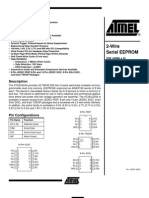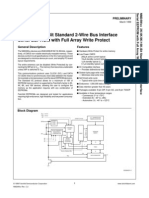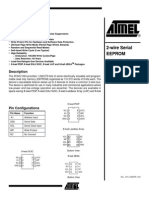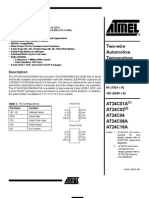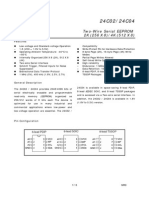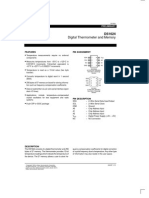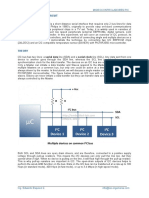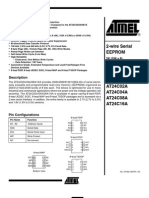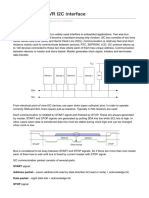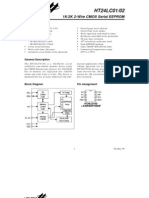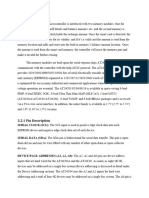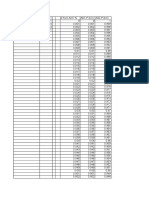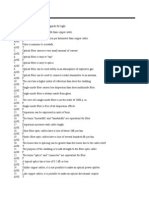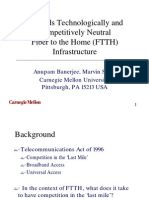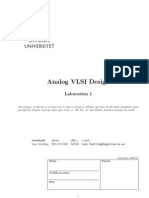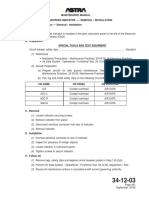24C02
24C02
Uploaded by
Biswajit SarkarCopyright:
Available Formats
24C02
24C02
Uploaded by
Biswajit SarkarOriginal Title
Copyright
Available Formats
Share this document
Did you find this document useful?
Is this content inappropriate?
Copyright:
Available Formats
24C02
24C02
Uploaded by
Biswajit SarkarCopyright:
Available Formats
M24C16, M24C08 M24C04, M24C02, M24C01
16/8/4/2/1 Kbit Serial IC Bus EEPROM
FEATURES SUMMARY 2 I Two Wire I C Serial Interface Supports 400 kHz Protocol
I
Figure 1. Packages
Single Supply Voltage: 4.5V to 5.5V for M24Cxx 2.5V to 5.5V for M24Cxx-W 2.2V to 5.5V for M24Cxx-L 1.8V to 5.5V for M24Cxx-R 1.8V to 3.6V for M24Cxx-S
8 1
PDIP8 (BN)
I I I I I I I I
Write Control Input BYTE and PAGE WRITE (up to 16 Bytes) RANDOM and SEQUENTIAL READ Modes Self-Timed Programming Cycle Automatic Address Incrementing Enhanced ESD/Latch-Up Behavior More than 1 Million Erase/Write Cycles More than 40 Year Data Retention
8 1
SO8 (MN) 150 mil width
TSSOP8 (DW) 169 mil width
TSSOP8 (DS) 3x3mm body size (MSOP)
July 2002
1/27
M24C16, M24C08, M24C04, M24C02, M24C01
SUMMARY DESCRIPTION These I2C-compatible electrically erasable programmable memory (EEPROM) devices are organized as 2048/1024/512/256/128 x 8 (M24C16, M24C08, M24C04, M24C02, M24C01). Figure 2. Logic Diagram
VCC
Select Code and RW bit (as described in Table 2), terminated by an acknowledge bit. When writing data to the memory, the device inserts an acknowledge bit during the 9th bit time, following the bus masters 8-bit transmission. When data is read by the bus master, the bus master acknowledges the receipt of the data byte in the same way. Data transfers are terminated by a Stop condition after an Ack for Write, and after a NoAck for Read. Table 1. Signal Names
3 E0-E2 SCL WC M24Cxx SDA
E0, E1, E2 SDA SCL WC VCC
Chip Enable Serial Data Serial Clock Write Control Supply Voltage Ground
VSS
AI02033
VSS
These devices are compatible with the I2C memory protocol. This is a two wire serial interface that uses a bi-directional data bus and serial clock. The devices carry a built-in 4-bit Device Type Identifier code (1010) in accordance with the I2C bus definition. The device behaves as a slave in the I2C protocol, with all memory operations synchronized by the serial clock. Read and Write operations are initiated by a Start condition, generated by the bus master. The Start condition is followed by a Device Figure 3. DIP, SO and TSSOP Connections
M24Cxx 16Kb /8Kb /4Kb /2Kb /1Kb NC / NC / NC / E0 / E0 NC / NC / E1 / E1 / E1 NC / E2 / E2 / E2 / E2 VSS
Power On Reset: V CC Lock-Out Write Protect In order to prevent data corruption and inadvertent Write operations during Power-up, a Power On Reset (POR) circuit is included. The internal reset is held active until VCC has reached the POR threshold value, and all operations are disabled the device will not respond to any command. In the same way, when VCC drops from the operating voltage, below the POR threshold value, all operations are disabled and the device will not respond to any command. A stable and valid V CC must be applied before applying any logic signal.
1 2 3 4
8 7 6 5
VCC WC SCL SDA
AI02034E
Note: 1. NC = Not Connected
2/27
M24C16, M24C08, M24C04, M24C02, M24C01
SIGNAL DESCRIPTION Serial Clock (SCL) This input signal is used to strobe all data in and out of the device. In applications where this signal is used by slave devices to synchronize the bus to a slower clock, the bus master must have an open drain output, and a pull-up resistor can be connected from Serial Clock (SCL) to VCC. (Figure 4 indicates how the value of the pull-up resistor can be calculated). In most applications, though, this method of synchronization is not employed, and so the pull-up resistor is not necessary, provided that the bus master has a push-pull (rather than open drain) output. Serial Data (SDA) This bi-directional signal is used to transfer data in or out of the device. It is an open drain output that may be wire-ORed with other open drain or open collector signals on the bus. A pull up resistor must be connected from Serial Data (SDA) to V CC. (Figure 4 indicates how the value of the pull-up resistor can be calculated).
Chip Enable (E0, E1, E2) These input signals are used to set the value that is to be looked for on the three least significant bits (b3, b2, b1) of the 7-bit Device Select Code. These inputs must be tied to V CC or VSS, to establish the Device Select Code. Write Control (WC) This input signal is useful for protecting the entire contents of the memory from inadvertent write operations. Write operations are disabled to the entire memory array when Write Control (WC) is driven High. When unconnected, the signal is internally read as VIL, and Write operations are allowed. When Write Control (WC) is driven High, Device Select and Address bytes are acknowledged, Data bytes are not acknowledged.
Figure 4. Maximum R L Value versus Bus Capacitance (CBUS) for an I2C Bus
VCC 20 Maximum RP value (k) 16 RL 12 8 4 0 10 100 CBUS (pF)
AI01665
RL
SDA MASTER fc = 100kHz fc = 400kHz SCL CBUS
CBUS 1000
3/27
M24C16, M24C08, M24C04, M24C02, M24C01
Figure 5. I2C Bus Protocol
SCL
SDA SDA Input SDA Change
START Condition
STOP Condition
SCL
SDA
MSB
ACK
START Condition
SCL
SDA
MSB
ACK
STOP Condition
AI00792B
Table 2. Device Select Code
Device Type Identifier1 b7 M24C01 Select Code M24C02 Select Code M24C04 Select Code M24C08 Select Code M24C16 Select Code 1 1 1 1 1 b6 0 0 0 0 0 b5 1 1 1 1 1 b4 0 0 0 0 0 b3 E2 E2 E2 E2 A10 Chip Enable2,3 b2 E1 E1 E1 A9 A9 b1 E0 E0 A8 A8 A8 RW b0 RW RW RW RW RW
Note: 1. The most significant bit, b7, is sent first. 2. E0, E1 and E2 are compared against the respective external pins on the memory device. 3. A10, A9 and A8 represent most significant bits of the address.
4/27
M24C16, M24C08, M24C04, M24C02, M24C01
DEVICE OPERATION The device supports the I2C protocol. This is summarized in Figure 5. Any device that sends data on to the bus is defined to be a transmitter, and any device that reads the data to be a receiver. The device that controls the data transfer is known as the bus master, and the other as the slave device. A data transfer can only be initiated by the bus master, which will also provide the serial clock for synchronization. The M24Cxx device is always a slave in all communication. Start Condition Start is identified by a falling edge of Serial Data (SDA) while Serial Clock (SCL) is stable in the High state. A Start condition must precede any data transfer command. The device continuously monitors (except during a Write cycle) Serial Data (SDA) and Serial Clock (SCL) for a Start condition, and will not respond unless one is given. Stop Condition Stop is identified by a rising edge of Serial Data (SDA) while Serial Clock (SCL) is stable and driven High. A Stop condition terminates communication between the device and the bus master. A Read command that is followed by NoAck can be followed by a Stop condition to force the device into the Stand-by mode. A Stop condition at the end of a Write command triggers the internal EEPROM Write cycle. Acknowledge Bit (ACK) The acknowledge bit is used to indicate a successful byte transfer. The bus transmitter, whether it be bus master or slave device, releases Serial Data (SDA) after sending eight bits of data. During the 9th clock pulse period, the receiver pulls Serial Data (SDA) Low to acknowledge the receipt of the eight data bits. Data Input During data input, the device samples Serial Data (SDA) on the rising edge of Serial Clock (SCL). For correct device operation, Serial Data (SDA) Table 3. Operating Modes
Mode Current Address Read Random Address Read 1 Sequential Read Byte Write Page Write
Note: 1. X = VIH or VIL.
must be stable during the rising edge of Serial Clock (SCL), and the Serial Data (SDA) signal must change only when Serial Clock (SCL) is driven Low. Memory Addressing To start communication between the bus master and the slave device, the bus master must initiate a Start condition. Following this, the bus master sends the Device Select Code, shown in Table 2 (on Serial Data (SDA), most significant bit first). The Device Select Code consists of a 4-bit Device Type Identifier, and a 3-bit Chip Enable Address (E2, E1, E0). To address the memory array, the 4bit Device Type Identifier is 1010b. When the Device Select Code is received on Serial Data (SDA), the device only responds if the Chip Enable Address is the same as the value on the Chip Enable (E0, E1, E2) inputs. The 8th bit is the Read/Write bit (RW). This bit is set to 1 for Read and 0 for Write operations. If a match occurs on the Device Select code, the corresponding device gives an acknowledgment on Serial Data (SDA) during the 9th bit time. If the device does not match the Device Select code, it deselects itself from the bus, and goes into Standby mode. Devices with larger memory capacities (the M24C16, M24C08 and M24C04) need more address bits. E0 is not available for use on devices that need to use address line A8; E1 is not available for devices that need to use address line A9, and E2 is not available for devices that need to use address line A10 (see Figure 3 and Table 2 for details). Using the E0, E1 and E2 inputs pins, up to eight M24C02 (or M24C01), four M24C04, two M24C08 or one M24C16 device can be connected to one I2C bus. In each case, and in the hybrid cases, this gives a total memory capacity of 16 Kbits, 2 KBytes (except where M24C01 devices are used).
RW bit 1 0
WC 1 X X
Bytes 1 1
Initial Sequence START, Device Select, RW = 1 START, Device Select, RW = 0, Address reSTART, Device Select, RW = 1
X X VIL VIL 1 1
1 0 0
Similar to Current or Random Address Read START, Device Select, RW = 0
16
START, Device Select, RW = 0
5/27
M24C16, M24C08, M24C04, M24C02, M24C01
Figure 6. Write Mode Sequences with WC=1 (data write inhibited)
WC ACK Byte Write START DEV SEL R/W ACK NO ACK DATA IN STOP ACK NO ACK DATA IN 1
BYTE ADDR
WC ACK Page Write START DEV SEL R/W NO ACK DATA IN 3
BYTE ADDR
DATA IN 2
WC (cont'd) NO ACK Page Write (cont'd) NO ACK
DATA IN N STOP
AI02803C
Write Operations Following a Start condition the bus master sends a Device Select Code with the RW bit reset to 0. The device acknowledges this, as shown in Figure 7, and waits for an address byte. The device responds to the address byte with an acknowledge bit, and then waits for the data byte. When the bus master generates a Stop condition immediately after the Ack bit (in the 10 th bit time slot), either at the end of a Byte Write or a Page Write, the internal memory Write cycle is triggered. A Stop condition at any other time slot does not trigger the internal Write cycle. During the internal Write cycle, Serial Data (SDA) and Serial Clock (SCL) are ignored, and the device does not respond to any requests. Byte Write After the Device Select code and the address byte, the bus master sends one data byte. If the addressed location is Write-protected, by Write Control (WC) being driven High (during the period from
6/27
the Start condition until the end of the address byte), the device replies to the data byte with NoAck, as shown in Figure 6, and the location is not modified. If, instead, the addressed location is not Write-protected, the device replies with Ack. The bus master terminates the transfer by generating a Stop condition, as shown in Figure 7. Page Write The Page Write mode allows up to 16 bytes to be written in a single Write cycle, provided that they are all located in the same page in the memory: that is, the most significant memory address bits are the same. If more bytes are sent than will fit up to the end of the page, a condition known as rollover occurs. This should be avoided, as data starts to become overwritten in an implementation dependent way. The bus master sends from 1 to 16 bytes of data, each of which is acknowledged by the device if Write Control (WC) is Low. If the addressed location is Write-protected, by Write Control (WC) being driven High (during the period from the Start
M24C16, M24C08, M24C04, M24C02, M24C01
condition until the end of the address byte), the device replies to the data bytes with NoAck, as shown in Figure 6, and the locations are not modified. After each byte is transferred, the internal byte address counter (the 4 least significant address bits only) is incremented. The transfer is terminated by the bus master generating a Stop condition.
Figure 7. Write Mode Sequences with WC=0 (data write enabled)
WC ACK BYTE WRITE START DEV SEL R/W ACK DATA IN STOP ACK DATA IN 1 ACK DATA IN 2 ACK
BYTE ADDR
WC ACK PAGE WRITE START DEV SEL R/W ACK DATA IN 3
BYTE ADDR
WC (cont'd)
ACK PAGE WRITE (cont'd) DATA IN N
ACK
STOP
AI02804B
7/27
M24C16, M24C08, M24C04, M24C02, M24C01
Figure 8. Write Cycle Polling Flowchart using ACK
WRITE Cycle in Progress
START Condition DEVICE SELECT with RW = 0
NO First byte of instruction with RW = 0 already decoded by the device
ACK Returned YES
NO
Next Operation is Addressing the Memory
YES
ReSTART
Send Address and Receive ACK
STOP
NO
START Condition
YES
DATA for the WRITE Operation
DEVICE SELECT with RW = 1
Continue the WRITE Operation
Continue the Random READ Operation
AI01847C
Minimizing System Delays by Polling On ACK During the internal Write cycle, the device disconnects itself from the bus, and writes a copy of the data from its internal latches to the memory cells. The maximum Write time (tw) is shown in Tables 19 to 21, but the typical time is shorter. To make use of this, a polling sequence can be used by the bus master. The sequence, as shown in Figure 8, is: Initial condition: a Write cycle is in progress.
Step 1: the bus master issues a Start condition followed by a Device Select Code (the first byte of the new instruction). Step 2: if the device is busy with the internal Write cycle, no Ack will be returned and the bus master goes back to Step 1. If the device has terminated the internal Write cycle, it responds with an Ack, indicating that the device is ready to receive the second part of the instruction (the first byte of this instruction having been sent during Step 1).
8/27
M24C16, M24C08, M24C04, M24C02, M24C01
Figure 9. Read Mode Sequences
ACK CURRENT ADDRESS READ START DEV SEL R/W NO ACK DATA OUT STOP ACK DEV SEL * START R/W
ACK RANDOM ADDRESS READ START DEV SEL * R/W
ACK
NO ACK DATA OUT STOP NO ACK ACK
AI01942
BYTE ADDR
ACK SEQUENTIAL CURRENT READ START DEV SEL R/W
ACK
ACK
DATA OUT 1
DATA OUT N STOP
ACK SEQUENTIAL RANDOM READ START DEV SEL * R/W
ACK DEV SEL * START
ACK
BYTE ADDR
DATA OUT 1 R/W
ACK
NO ACK
DATA OUT N STOP
Note: 1. The seven most significant bits of the Device Select Code of a Random Read (in the 1 st and 3rd bytes) must be identical.
Read Operations Read operations are performed independently of the state of the Write Control (WC) signal. Random Address Read A dummy Write is performed to load the address into the address counter (as shown in Figure 9) but without sending a Stop condition. Then, the bus master sends another Start condition, and repeats the Device Select Code, with the RW bit set to 1. The device acknowledges this, and outputs the contents of the addressed byte. The bus master
must not acknowledge the byte, and terminates the transfer with a Stop condition. Current Address Read The device has an internal address counter which is incremented each time a byte is read. For the Current Address Read operation, following a Start condition, the bus master only sends a Device Select Code with the RW bit set to 1. The device acknowledges this, and outputs the byte addressed by the internal address counter. The counter is then incremented. The bus master terminates the transfer with a Stop condition, as shown in Figure 9, without acknowledging the byte.
9/27
M24C16, M24C08, M24C04, M24C02, M24C01
Sequential Read This operation can be used after a Current Address Read or a Random Address Read. The bus master does acknowledge the data byte output, and sends additional clock pulses so that the device continues to output the next byte in sequence. To terminate the stream of bytes, the bus master must not acknowledge the last byte, and must generate a Stop condition, as shown in Figure 9. The output data comes from consecutive addresses, with the internal address counter automatically incremented after each byte output. After the last memory address, the address counter rolls-over, and the device continues to output data from memory address 00h. Acknowledge in Read Mode For all Read commands, the device waits, after each byte read, for an acknowledgment during the 9th bit time. If the bus master does not drive Serial Data (SDA) Low during this time, the device terminates the data transfer and switches to its Stand-by mode.
10/27
M24C16, M24C08, M24C04, M24C02, M24C01
MAXIMUM RATING Stressing the device above the rating listed in the Absolute Maximum Ratings" table may cause permanent damage to the device. These are stress ratings only and operation of the device at these or any other conditions above those indicated in the Operating sections of this specification is not imTable 4. Absolute Maximum Ratings
Symbol TSTG TLEAD VIO VCC VESD Storage Temperature Lead Temperature during Soldering Input or Output range Supply Voltage Electrostatic Discharge Voltage (Human Body model) 2 PDIP: 10 seconds SO: 20 seconds (max) 1 TSSOP: 20 seconds (max) 1 0.6 0.3 4000 Parameter Min. 65 Max. 150 260 235 235 6.5 6.5 4000 Unit C C V V V
plied. Exposure to Absolute Maximum Rating conditions for extended periods may affect device reliability. Refer also to the STMicroelectronics SURE Program and other relevant quality documents.
Note: 1. IPC/JEDEC J-STD-020A 2. JEDEC Std JESD22-A114A (C1=100 pF, R1=1500 , R2=500 )
11/27
M24C16, M24C08, M24C04, M24C02, M24C01
DC AND AC PARAMETERS This section summarizes the operating and measurement conditions, and the DC and AC characteristics of the device. The parameters in the DC and AC Characteristic tables that follow are derived from tests performed under the MeasureTable 5. Operating Conditions (M24Cxx-xx6)
Symbol VCC TA Supply Voltage Ambient Operating Temperature Parameter Min. 4.5 40 Max. 5.5 85 Unit V C
ment Conditions summarized in the relevant tables. Designers should check that the operating conditions in their circuit match the measurement conditions when relying on the quoted parameters.
Table 6. Operating Conditions (M24Cxx-xx3)
Symbol VCC TA Supply Voltage Ambient Operating Temperature Parameter Min. 4.5 40 Max. 5.5 125 Unit V C
Table 7. Operating Conditions (M24Cxx-Wxx6)
Symbol VCC TA Supply Voltage Ambient Operating Temperature Parameter Min. 2.5 40 Max. 5.5 85 Unit V C
Table 8. Operating Conditions (M24Cxx-Lxx6)
Symbol VCC TA Supply Voltage Ambient Operating Temperature Parameter Min. 2.2 40 Max. 5.5 85 Unit V C
Table 9. Operating Conditions (M24Cxx-Rxx6)
Symbol VCC TA Supply Voltage Ambient Operating Temperature Parameter Min. 1.8 40 Max. 5.5 85 Unit V C
Table 10. Operating Conditions (M24Cxx-Sxx6)
Symbol VCC TA Supply Voltage Ambient Operating Temperature Parameter Min. 1.8 40 Max. 3.6 85 Unit V C
12/27
M24C16, M24C08, M24C04, M24C02, M24C01
Table 11. AC Measurement Conditions
Symbol CL Load Capacitance Input Rise and Fall Times Input Levels Input and Output Timing Reference Levels Parameter Min. 100 50 0.2VCC to 0.8VCC 0.3VCC to 0.7VCC Max. Unit pF ns V V
Figure 10. AC Measurement I/O Waveform
Input Levels 0.8VCC Input and Output Timing Reference Levels 0.7VCC 0.3VCC
AI00825B
0.2VCC
Table 12. Input Parameters
Symbol CIN CIN ZWCL ZWCH tNS Parameter1,2 Input Capacitance (SDA) Input Capacitance (other pins) WC Input Impedance WC Input Impedance Pulse width ignored (Input Filter on SCL and SDA) VIN < 0.5 V VIN > 0.7VCC Single glitch 5 500 100 Test Condition Min. Max. 8 6 70 Unit pF pF k k ns
Note: 1. TA = 25 C, f = 400 kHz 2. Sampled only, not 100% tested.
13/27
M24C16, M24C08, M24C04, M24C02, M24C01
Table 13. DC Characteristics (M24Cxx-xx6)
Symbol ILI ILO ICC ICC1 Parameter Input Leakage Current (SCL, SDA) Output Leakage Current Supply Current Stand-by Supply Current Input Low Voltage (E0, E1, E2, SCL, SDA) Input Low Voltage (WC) VIH VOL Input High Voltage (E0, E1, E2, SCL, SDA, WC) Output Low Voltage IOL = 3 mA, VCC = 5 V Test Condition (in addition to those in Table 5) VIN = VSS or VCC VOUT = VSS or VCC, SDA in Hi-Z VCC=5V, fc=400kHz (rise/fall time < 30ns) VIN = VSS or VCC , VCC = 5 V 0.3 0.3 0.7VCC Min. Max. 2 2 2 1 0.3VCC 0.5 VCC+1 0.4 Unit A A mA A V V V V
VIL
Table 14. DC Characteristics (M24Cxx-xx3)
Symbol ILI ILO ICC ICC1 Parameter Input Leakage Current (SCL, SDA) Output Leakage Current Supply Current Stand-by Supply Current Input Low Voltage (E0, E1, E2, SCL, SDA) Input Low Voltage (WC) VIH VOL Input High Voltage (E0, E1, E2, SCL, SDA, WC) Output Low Voltage IOL = 3 mA, VCC = 5 V Test Condition (in addition to those in Table 6) VIN = VSS or VCC VOUT = VSS or VCC, SDA in Hi-Z VCC=5V, fc=400kHz (rise/fall time < 30ns) VIN = VSS or VCC , VCC = 5 V 0.3 0.3 0.7VCC Min.1 Max.1 2 2 3 5 0.3VCC 0.5 VCC+1 0.4 Unit A A mA A V V V V
VIL
Note: 1. This is preliminary data.
14/27
M24C16, M24C08, M24C04, M24C02, M24C01
Table 15. DC Characteristics (M24Cxx-Wxx6)
Symbol ILI ILO ICC ICC1 Parameter Input Leakage Current (SCL, SDA) Output Leakage Current Supply Current Stand-by Supply Current Input Low Voltage (E0, E1, E2, SCL, SDA) Input Low Voltage (WC) VIH VOL Input High Voltage (E0, E1, E2, SCL, SDA, WC) Output Low Voltage IOL = 2.1 mA, VCC = 2.5 V Test Condition (in addition to those in Table 7) VIN = VSS or VCC VOUT = VSS or VCC, SDA in Hi-Z VCC =2.5V, fc=400kHz (rise/fall time < 30ns) VIN = VSS or VCC , VCC = 2.5 V 0.3 0.3 0.7VCC Min. Max. 2 2 1 0.5 0.3VCC 0.5 VCC+1 0.4 Unit A A mA A V V V V
VIL
Table 16. DC Characteristics (M24Cxx-Lxx6)
Symbol ILI ILO ICC ICC1 Parameter Input Leakage Current (SCL, SDA) Output Leakage Current Supply Current Stand-by Supply Current Input Low Voltage (E0, E1, E2, SCL, SDA) Input Low Voltage (WC) VIH VOL Input High Voltage (E0, E1, E2, SCL, SDA, WC) Output Low Voltage IOL = 2.1 mA, VCC = 2.2 V Test Condition (in addition to those in Table 8) VIN = VSS or VCC VOUT = VSS or VCC, SDA in Hi-Z VCC =2.5V, fc=400kHz (rise/fall time < 30ns) VIN = VSS or VCC , VCC = 2.5 V 0.3 0.3 0.7VCC Min. Max. 2 2 1 0.5 0.3VCC 0.5 VCC+1 0.4 Unit A A mA A V V V V
VIL
15/27
M24C16, M24C08, M24C04, M24C02, M24C01
Table 17. DC Characteristics (M24Cxx-Rxx6)
Symbol ILI ILO ICC ICC1 Parameter Input Leakage Current (SCL, SDA) Output Leakage Current Supply Current Stand-by Supply Current Input Low Voltage (E0, E1, E2, SCL, SDA) Input Low Voltage (WC) VIH VOL Input High Voltage (E0, E1, E2, SCL, SDA, WC) Output Low Voltage IOL = 0.7 mA, VCC = 1.8 V Test Condition (in addition to those in Table 9) VIN = VSS or VCC VOUT = VSS or VCC, SDA in Hi-Z VCC =1.8V, fc=100kHz (rise/fall time < 30ns) VIN = VSS or VCC , VCC = 1.8 V 2.5 V VCC 1.8 V VCC < 2.5 V 0.3 0.3 0.3 0.7VCC Min. Max. 2 2 0.81 0.31 0.3 VCC1 0.25 VCC1 0.5 VCC+1 0.21 Unit A A mA A V V V V V
VIL
Note: 1. This is preliminary data.
Table 18. DC Characteristics (M24Cxx-Sxx6)
Symbol ILI ILO ICC ICC1 Parameter Input Leakage Current (SCL, SDA) Output Leakage Current Supply Current Stand-by Supply Current Input Low Voltage (E0, E1, E2, SCL, SDA) Input Low Voltage (WC) VIH VOL Input High Voltage (E0, E1, E2, SCL, SDA, WC) Output Low Voltage IOL = 0.7 mA, VCC = 1.8 V Test Condition (in addition to those in Table 10) VIN = VSS or VCC VOUT = VSS or VCC, SDA in Hi-Z VCC =1.8V, fc=400kHz (rise/fall time < 30ns) VIN = VSS or VCC , VCC = 1.8 V 2.5 V VCC 1.8 V VCC < 2.5 V 0.3 0.3 0.3 0.7VCC Min. Max. 2 2 0.81 0.31 0.3 VCC1 0.25 VCC1 0.5 VCC+1 0.21 Unit A A mA A V V V V V
VIL
Note: 1. This is preliminary data.
16/27
M24C16, M24C08, M24C04, M24C02, M24C01
Table 19. AC Characteristics (M24Cxx-xx6)
Test conditions specified in Table 11 and Table 5 Symbol fC tCHCL tCLCH tCH1CH2 tCL1CL2 tDH1DH2 2 tDL1DL2 2 tDXCX tCLDX tCLQX tCLQV 3 tCHDX 1 tDLCL tCHDH tDHDL tW Alt. fSCL tHIGH tLOW tR tF tR tF tSU:DAT tHD:DAT tDH tAA tSU:STA tHD:STA tSU:STO tBUF tWR Clock Frequency Clock Pulse Width High Clock Pulse Width Low Clock Rise Time Clock Fall Time SDA Rise Time SDA Fall Time Data In Set Up Time Data In Hold Time Data Out Hold Time Clock Low to Next Data Valid (Access Time) Start Condition Set Up Time Start Condition Hold Time Stop Condition Set Up Time Time between Stop Condition and Next Start Condition Write Time 20 20 100 0 200 200 600 600 600 1300 5 900 600 1300 300 300 300 300 Parameter Min. Max. 400 Unit kHz ns ns ns ns ns ns ns ns ns ns ns ns ns ns ms
Note: 1. For a reSTART condition, or following a Write cycle. 2. Sampled only, not 100% tested. 3. To avoid spurious START and STOP conditions, a minimum delay is placed between SCL=1 and the falling or rising edge of SDA.
17/27
M24C16, M24C08, M24C04, M24C02, M24C01
Table 20. AC Characteristics (M24Cxx-xx3, M24Cxx-Wxx6, M24Cxx-Lxx6, M24Cxx-Sxx6)
Test conditions specified in Table 11 and Table 6 or 7 or 8 or 9 Symbol fC tCHCL tCLCH tCH1CH2 tCL1CL2 tDH1DH2 2 tDL1DL2 2 tDXCX tCLDX tCLQX tCLQV
3
Alt. fSCL tHIGH tLOW tR tF tR tF tSU:DAT tHD:DAT tDH tAA tSU:STA tHD:STA tSU:STO tBUF tWR Clock Frequency
Parameter
Min.4
Max.4 400
Unit kHz ns ns
Clock Pulse Width High Clock Pulse Width Low Clock Rise Time Clock Fall Time SDA Rise Time SDA Fall Time Data In Set Up Time Data In Hold Time Data Out Hold Time Clock Low to Next Data Valid (Access Time) Start Condition Set Up Time Start Condition Hold Time Stop Condition Set Up Time Time between Stop Condition and Next Start Condition Write Time
600 1300 300 300 20 20 100 0 200 200 600 600 600 1300 10 900 300 300
ns ns ns ns ns ns ns ns ns ns ns ns ms
tCHDX 1 tDLCL tCHDH tDHDL tW
Note: 1. 2. 3. 4.
For a reSTART condition, or following a Write cycle. Sampled only, not 100% tested. To avoid spurious START and STOP conditions, a minimum delay is placed between SCL=1 and the falling or rising edge of SDA. This is preliminary data for M24Cxx-xx3 and M24Cxx-Rxx6
18/27
M24C16, M24C08, M24C04, M24C02, M24C01
Table 21. AC Characteristics (M24Cxx-Rxx6)
Test conditions specified in Table 11 and Table 10 Symbol fC tCHCL tCLCH tCH1CH2 tCL1CL2 tDH1DH2 2 tDL1DL2 2 tDXCX tCLDX tCLQX tCLQV
3
Alt. fSCL tHIGH tLOW tR tF tR tF tSU:DAT tHD:DAT tDH tAA tSU:STA tHD:STA tSU:STO tBUF tWR Clock Frequency
Parameter
Min.4
Max.4 100
Unit kHz ns ns
Clock Pulse Width High Clock Pulse Width Low Clock Rise Time Clock Fall Time SDA Rise Time SDA Fall Time Data In Set Up Time Data In Hold Time Data Out Hold Time Clock Low to Next Data Valid (Access Time) Start Condition Set Up Time Start Condition Hold Time Stop Condition Set Up Time Time between Stop Condition and Next Start Condition Write Time
4000 4700 1000 300 20 20 250 0 200 200 4700 4000 4000 4700 10 3500 1000 300
ns ns ns ns ns ns ns ns ns ns ns ns ms
tCHDX 1 tDLCL tCHDH tDHDL tW
Note: 1. 2. 3. 4.
For a reSTART condition, or following a Write cycle. Sampled only, not 100% tested. To avoid spurious START and STOP conditions, a minimum delay is placed between SCL=1 and the falling or rising edge of SDA. This is preliminary data.
19/27
M24C16, M24C08, M24C04, M24C02, M24C01
Figure 11. AC Waveforms
tCHCL
tCLCH
SCL tDLCL SDA In tCHDX START Condition SDA Input tCLDX SDA tDXCX Change tCHDH tDHDL START STOP Condition Condition
SCL
SDA In tCHDH STOP Condition tW Write Cycle tCHDX START Condition
SCL tCLQV SDA Out Data Valid tCLQX
AI00795C
20/27
M24C16, M24C08, M24C04, M24C02, M24C01
PACKAGE MECHANICAL PDIP8 8 pin Plastic DIP, 0.25mm lead frame, Package Outline
b2 A2 A1 b e A L
c eA eB
D
8
E1
1 PDIP-B
Notes: 1. Drawing is not to scale.
PDIP8 8 pin Plastic DIP, 0.25mm lead frame, Package Mechanical Data
mm Symb. Typ. A A1 A2 b b2 c D E E1 e eA eB L 3.30 2.92 3.30 0.46 1.52 0.25 9.27 7.87 6.35 2.54 7.62 0.38 2.92 0.36 1.14 0.20 9.02 7.62 6.10 4.95 0.56 1.78 0.36 10.16 8.26 7.11 10.92 3.81 0.130 0.115 0.130 0.018 0.060 0.010 0.365 0.310 0.250 0.100 0.300 Min. Max. 5.33 0.015 0.115 0.014 0.045 0.008 0.355 0.300 0.240 0.195 0.022 0.070 0.014 0.400 0.325 0.280 0.430 0.150 Typ. Min. Max. 0.210 inches
21/27
M24C16, M24C08, M24C04, M24C02, M24C01
SO8 narrow 8 lead Plastic Small Outline, 150 mils body width, Package Outline
h x 45 A C B e D CP
E
1
H A1 L
SO-a
Note: Drawing is not to scale.
SO8 narrow 8 lead Plastic Small Outline, 150 mils body width, Package Mechanical Data
mm Symb. Typ. A A1 B C D E e H h L N CP 1.27 Min. 1.35 0.10 0.33 0.19 4.80 3.80 5.80 0.25 0.40 0 8 0.10 Max. 1.75 0.25 0.51 0.25 5.00 4.00 6.20 0.50 0.90 8 0.050 Typ. Min. 0.053 0.004 0.013 0.007 0.189 0.150 0.228 0.010 0.016 0 8 0.004 Max. 0.069 0.010 0.020 0.010 0.197 0.157 0.244 0.020 0.035 8 inches
22/27
M24C16, M24C08, M24C04, M24C02, M24C01
TSSOP8 8 lead Thin Shrink Small Outline, Package Outline
c
E1 E
A1 A CP b e A2
L L1
TSSOP8AM
Notes: 1. Drawing is not to scale.
TSSOP8 8 lead Thin Shrink Small Outline, Package Mechanical Data
mm Symbol Typ. A A1 A2 b c CP D e E E1 L L1 3.000 0.650 6.400 4.400 0.600 1.000 0 8 2.900 6.200 4.300 0.450 1.000 0.050 0.800 0.190 0.090 Min. Max. 1.200 0.150 1.050 0.300 0.200 0.100 3.100 6.600 4.500 0.750 0.1181 0.0256 0.2520 0.1732 0.0236 0.0394 0 8 0.1142 0.2441 0.1693 0.0177 0.0394 0.0020 0.0315 0.0075 0.0035 Typ. Min. Max. 0.0472 0.0059 0.0413 0.0118 0.0079 0.0039 0.1220 0.2598 0.1772 0.0295 inches
23/27
M24C16, M24C08, M24C04, M24C02, M24C01
TSSOP8 3x3mm 8 lead Thin Shrink Small Outline, 3x3mm body size, Package Outline
5 E1 E
A1 A CP b e A2
L L1
TSSOP8BM
Notes: 1. Drawing is not to scale.
TSSOP8 3x3mm 8 lead Thin Shrink Small Outline, 3x3mm body size, Package Mechanical Data
mm Symbol Typ. A A1 A2 b c D E E1 e CP L L1 0.550 0.950 0 6 0.400 3.000 4.900 3.000 0.650 0.850 0.050 0.750 0.250 0.130 2.900 4.650 2.900 Min. Max. 1.100 0.150 0.950 0.400 0.230 3.100 5.150 3.100 0.100 0.700 0.0217 0.0374 0 6 0.0157 0.1181 0.1929 0.1181 0.0256 0.0335 0.0020 0.0295 0.0098 0.0051 0.1142 0.1831 0.1142 Typ. Min. Max. 0.0433 0.0059 0.0374 0.0157 0.0091 0.1220 0.2028 0.1220 0.0039 0.0276 inches
24/27
M24C16, M24C08, M24C04, M24C02, M24C01
PART NUMBERING Table 22. Ordering Information Scheme
Example: Device Type M24 = I2C serial access EEPROM Device Function 16 = 16 Kbit (2048 x 8) 08 = 8 Kbit (1024 x 8) 04 = 4 Kbit (512 x 8) 02 = 2 Kbit (256 x 8) 01 = 1 Kbit (128 x 8) Operating Voltage blank = VCC = 4.5 to 5.5V (400kHz) W = VCC = 2.5 to 5.5V (400kHz) L = VCC = 2.2 to 5.5V (400kHz) R = VCC = 1.8 to 5.5V (100kHz) S = VCC = 1.8 to 3.6V (400kHz) Package BN = PDIP8 MN = SO8 (150 mil width) DW = TSSOP8 (169 mil width) DS = TSSOP8 (3x3mm body size, MSOP8) Temperature Range 6 = 40 to 85 C 3 = 40 to 125 C Option T = Tape & Reel Packing M24C08 W DW 6 T
For a list of available options (speed, package, etc.) or for further information on any aspect of this
device, please contact your nearest ST Sales Office.
25/27
M24C16, M24C08, M24C04, M24C02, M24C01
REVISION HISTORY Table 23. Document Revision History
Date 10-Dec-1999 18-Apr-2000 05-May-2000 23-Nov-2000 Rev. 2.4 2.5 2.6 3.0 Description of Revision TSSOP8 Turned-Die package removed (p 2 and order information) Lead temperature added for TSSOP8 in table 2 Labelling change to Fig-2D, correction of values for E and main caption for Tab-13 Extra labelling to Fig-2D SBGA package information removed to an annex document -R range changed to being the -S range, and the new -R range added SBGA package information put back in this document Lead Soldering Temperature in the Absolute Maximum Ratings table amended Write Cycle Polling Flow Chart using ACK illustration updated References to PSDIP changed to PDIP and Package Mechanical data updated Wording brought in to line with standard glossary Revision of DC and AC characteristics for the -S series Ball numbers added to the SBGA connections and package mechanical illustrations Specification of Test Condition for Leakage Currents in the DC Characteristics table improved Document reformated using new template. SBGA5 package removed TSSOP8 (3x3mm body size) package (MSOP8) added. -L voltage range added
19-Feb-2001
3.1
20-Apr-2001 08-Oct-2001 09-Nov-2001 30-Jul-2002
3.2 3.3 3.4 3.5
26/27
M24C16, M24C08, M24C04, M24C02, M24C01
Information furnished is believed to be accurate and reliable. However, STMicroelectronics assumes no responsibility for the consequences of use of such information nor for any infringement of patents or other rights of third parties which may result from its use. No license is granted by implication or otherwise under any patent or patent rights of STMicroelectronics. Specifications mentioned in this publication are subject to change without notice. This publication supersedes and replaces all information previously supplied. STMicroelectronics products are not authorized for use as critical components in life support devices or systems without express written approval of STMicroelectronics. The ST logo is registered trademark of STMicroelectronics All other names are the property of their respective owners 2002 STMicroelectronics - All Rights Reserved STMicroelectronics group of companies Australia - Brazil - Canada - China - Finland - France - Germany - Hong Kong India - Israel - Italy - Japan - Malaysia - Malta - Morocco - Singapore - Spain - Sweden - Switzerland - United Kingdom - United States. www.st.com
27/27
You might also like
- The 8051 Microcontroller and Embedded Systems Second Edition Muhammad Ali Mazidi Janice Gillispie Mazidi Rolin D. McKinlayDocument105 pagesThe 8051 Microcontroller and Embedded Systems Second Edition Muhammad Ali Mazidi Janice Gillispie Mazidi Rolin D. McKinlayprax_1259% (27)
- ARM Microcontrollers Programming for Embedded SystemsFrom EverandARM Microcontrollers Programming for Embedded SystemsRating: 5 out of 5 stars5/5 (1)
- ST24 25C04, ST24 25W04Document16 pagesST24 25C04, ST24 25W04Zoran KovacevicNo ratings yet
- 512 Kbit Serial I C Bus EEPROM: DescriptionDocument19 pages512 Kbit Serial I C Bus EEPROM: DescriptionJavier MainarNo ratings yet
- 24C02-8 EepromDocument16 pages24C02-8 EepromJesus Almanzar SantosNo ratings yet
- 24C02 24C04 24C08 24C16: Bookly MicroDocument10 pages24C02 24C04 24C08 24C16: Bookly MicroHùng Nguyễn VănNo ratings yet
- 24C64 BMDocument10 pages24C64 BMdonghungstbNo ratings yet
- 4.1.3 Definition of The EE1002 and EE1002A Serial Presence Detect (SPD) EEPROMS 1. ScopeDocument24 pages4.1.3 Definition of The EE1002 and EE1002A Serial Presence Detect (SPD) EEPROMS 1. ScopemboopathiNo ratings yet
- 24C64WPDocument15 pages24C64WPaldo_suviNo ratings yet
- Two-Wire Serial EEPROM 32K (4096 X 8) 64K (8192 X 8) AT24C32A AT24C64ADocument22 pagesTwo-Wire Serial EEPROM 32K (4096 X 8) 64K (8192 X 8) AT24C32A AT24C64ASergioNo ratings yet
- 2-Wire Serial EEPROM: FeaturesDocument23 pages2-Wire Serial EEPROM: FeaturesgillupilluNo ratings yet
- Br24c01a PDFDocument13 pagesBr24c01a PDFJesus LawrenceNo ratings yet
- 09 - I2C Serial CommunicationsmDocument10 pages09 - I2C Serial CommunicationsmSorabh DungNo ratings yet
- Doc0336 PDFDocument19 pagesDoc0336 PDFrajat jainNo ratings yet
- 24C02C SMDDocument16 pages24C02C SMDWalter RossiNo ratings yet
- Eeprom 24w04Document15 pagesEeprom 24w04davixformusicNo ratings yet
- Eeproms 24CXXDocument18 pagesEeproms 24CXXAlberto YepezNo ratings yet
- 24 LC 64Document12 pages24 LC 64achuthkumarNo ratings yet
- Atmel 24C02Document24 pagesAtmel 24C02chichedemorenoNo ratings yet
- Two-Wire Serial EEPROM: FeaturesDocument28 pagesTwo-Wire Serial EEPROM: FeaturesdobsrdjanNo ratings yet
- 4K 5.0V I C Serial EEPROM: Obsolete DeviceDocument14 pages4K 5.0V I C Serial EEPROM: Obsolete Devicefrank_grimesNo ratings yet
- Turbo IC, Inc.: Cmos I C 2-Wire Bus 4K Electrically Erasable Programmable Rom 512 X 8 Bit EepromDocument8 pagesTurbo IC, Inc.: Cmos I C 2-Wire Bus 4K Electrically Erasable Programmable Rom 512 X 8 Bit EepromMohamed ZayedNo ratings yet
- 24LC02 A2 PDFDocument11 pages24LC02 A2 PDFJavier Thus GavilanNo ratings yet
- Atmel 24C1024Document19 pagesAtmel 24C1024vax1No ratings yet
- Two-Wire Automotive Temperature Serial EEPROM: FeaturesDocument20 pagesTwo-Wire Automotive Temperature Serial EEPROM: Features강종운No ratings yet
- 24C512Document13 pages24C512kimbo23No ratings yet
- 24C 04Document15 pages24C 04Diego AsiconaNo ratings yet
- 24C02Document8 pages24C02laurentina52No ratings yet
- 24 LC 16Document12 pages24 LC 16Sebastian QuaroneNo ratings yet
- 24 LC 2561Document12 pages24 LC 2561ricardo_MassisNo ratings yet
- 64K 5.0V I C Smart Serial Eeprom: FeaturesDocument16 pages64K 5.0V I C Smart Serial Eeprom: FeaturesFerner BriceñoNo ratings yet
- PCF8582C-2: 1. DescriptionDocument21 pagesPCF8582C-2: 1. DescriptionroozbehxoxNo ratings yet
- 32K 5.0V I C Smart Serial Eeprom: Obsolete DeviceDocument15 pages32K 5.0V I C Smart Serial Eeprom: Obsolete DeviceDar KeyyNo ratings yet
- AtmelDocument19 pagesAtmelRobinHútNo ratings yet
- DS1624Document15 pagesDS1624jnax101No ratings yet
- EEprom 24 C65Document25 pagesEEprom 24 C65ESKALENONo ratings yet
- 16K 1.8V I C Serial EEPROM: FeaturesDocument12 pages16K 1.8V I C Serial EEPROM: FeaturesKrzysztof BondkaNo ratings yet
- I2C TutorialDocument9 pagesI2C TutorialLuis Angel Nina Sánchez100% (3)
- 2-Wire Serial Eeprom: FeaturesDocument21 pages2-Wire Serial Eeprom: FeaturesRenato Peñaloza CallaNo ratings yet
- programming Avr I2c InterfaceDocument11 pagesprogramming Avr I2c Interfacezbhp zNo ratings yet
- HT24LC01/02 CMOS Serial EEPROM Datasheet HoltekDocument8 pagesHT24LC01/02 CMOS Serial EEPROM Datasheet Holteksydubh72No ratings yet
- I2CDocument9 pagesI2CPrasanna VenkatesanNo ratings yet
- 24C32Document12 pages24C32Joao EfremNo ratings yet
- 24LC024Document22 pages24LC024David ChaoNo ratings yet
- 24Lc04B/08B: 4K/8K 2.5V I C Serial EepromsDocument12 pages24Lc04B/08B: 4K/8K 2.5V I C Serial EepromsBoris PopovNo ratings yet
- Add A DS1307 RTC Clock To Your AVR MicrocontrollerDocument14 pagesAdd A DS1307 RTC Clock To Your AVR MicrocontrolleriburolNo ratings yet
- 24 LC 16 BDocument12 pages24 LC 16 BAnonymous UxrPsIVNo ratings yet
- 3.2 Memory Modules: SERIAL CLOCK (SCL) : The SCL Input Is Used To Positive Edge Clock Data Into EachDocument8 pages3.2 Memory Modules: SERIAL CLOCK (SCL) : The SCL Input Is Used To Positive Edge Clock Data Into EachGeo BabuNo ratings yet
- 2-Wire Serial EEPROM: FeaturesDocument26 pages2-Wire Serial EEPROM: FeaturesLinkyNo ratings yet
- DS1302 Trickle-Charge Timekeeping ChipDocument13 pagesDS1302 Trickle-Charge Timekeeping ChipPravin MevadaNo ratings yet
- How To Use IIC On S08Document18 pagesHow To Use IIC On S08Manuel Enrique GutierrezNo ratings yet
- 256K SPI Bus Low-Power Serial SRAM: Device Selection TableDocument24 pages256K SPI Bus Low-Power Serial SRAM: Device Selection TableMarcinCholewaNo ratings yet
- Practical Reverse Engineering: x86, x64, ARM, Windows Kernel, Reversing Tools, and ObfuscationFrom EverandPractical Reverse Engineering: x86, x64, ARM, Windows Kernel, Reversing Tools, and ObfuscationNo ratings yet
- Analog Dialogue, Volume 48, Number 1: Analog Dialogue, #13From EverandAnalog Dialogue, Volume 48, Number 1: Analog Dialogue, #13Rating: 4 out of 5 stars4/5 (1)
- Industrial Automation Using MicrocontrollerDocument43 pagesIndustrial Automation Using MicrocontrollerBiswajit SarkarNo ratings yet
- Accountancy For 1st Year Diploma StudentsDocument408 pagesAccountancy For 1st Year Diploma StudentsBiswajit Sarkar100% (1)
- Ec403 Transmission Lines and Networks: Objective of The CourseDocument1 pageEc403 Transmission Lines and Networks: Objective of The CourseBiswajit SarkarNo ratings yet
- Seven Segment Based Alarm Clock Using 8051 MicrocontrollerDocument16 pagesSeven Segment Based Alarm Clock Using 8051 MicrocontrollerBiswajit SarkarNo ratings yet
- Uc Based Digital Clock With AlarmDocument10 pagesUc Based Digital Clock With AlarmBiswajit SarkarNo ratings yet
- Rapid Electronics LTD Data Sheet: Semiconductor Ic'SDocument1 pageRapid Electronics LTD Data Sheet: Semiconductor Ic'SBiswajit SarkarNo ratings yet
- P89V51RD2Document80 pagesP89V51RD2PsychosantNo ratings yet
- ULN2004AC-inversor LvadoraDocument8 pagesULN2004AC-inversor Lvadoraarturo_hernandez_78No ratings yet
- FQP6N60C/FQPF6N60C: 600V N-Channel MOSFETDocument10 pagesFQP6N60C/FQPF6N60C: 600V N-Channel MOSFETBiswajit SarkarNo ratings yet
- The 555 Timer IC (Adapted From) : CaseDocument12 pagesThe 555 Timer IC (Adapted From) : CaseBiswajit Sarkar100% (1)
- Interfacing Temperature SensorDocument2 pagesInterfacing Temperature SensorBiswajit SarkarNo ratings yet
- SmpcbookDocument460 pagesSmpcbookBiswajit SarkarNo ratings yet
- Mobile Controlled Robot DTMF: BRICS Summer Training Program 2010Document13 pagesMobile Controlled Robot DTMF: BRICS Summer Training Program 2010Biswajit SarkarNo ratings yet
- GSM Based Appliances Control Through SMS: Submitted byDocument6 pagesGSM Based Appliances Control Through SMS: Submitted byBiswajit SarkarNo ratings yet
- DTMF Based DeviceDocument5 pagesDTMF Based DeviceBiswajit SarkarNo ratings yet
- LookDocument1 pageLookBiswajit SarkarNo ratings yet
- Digital Signal Processing: Shi PingDocument31 pagesDigital Signal Processing: Shi PingGagandeep Singh DhingraNo ratings yet
- DES-098B: Multiple of SensorDocument1 pageDES-098B: Multiple of SensorLuis Alfredo Ramos FernandezNo ratings yet
- Lesson Plan Ee6651 CeDocument5 pagesLesson Plan Ee6651 CeSridhar JayaramanNo ratings yet
- Lithium Ion Batteries Price List-2022.03Document3 pagesLithium Ion Batteries Price List-2022.03Nates SalaNo ratings yet
- UpsDocument22 pagesUpsroshani007No ratings yet
- Es Model ExamDocument3 pagesEs Model ExamAarun ArasanNo ratings yet
- Linear Convolution: 'Enter The First Sequence: ' 'Enter The Second Sequence: 'Document16 pagesLinear Convolution: 'Enter The First Sequence: ' 'Enter The Second Sequence: 'myname_123No ratings yet
- Electric Machinery, 6th EditionDocument5 pagesElectric Machinery, 6th EditionSubha Kumar25% (4)
- Product Data Sheet: iPRD40 Modular Surge Arrester - 3P + N - 350VDocument2 pagesProduct Data Sheet: iPRD40 Modular Surge Arrester - 3P + N - 350VSurangaGNo ratings yet
- Atm3 4 2006 Mazanek 6 PDFDocument7 pagesAtm3 4 2006 Mazanek 6 PDFవేలుసామి లింగాసామిNo ratings yet
- 07xx Extronics RF Calculator FinalDocument98 pages07xx Extronics RF Calculator FinalroshankojuNo ratings yet
- Relayaux: Auxiliary Relays For Tripping and Control ApplicationsDocument28 pagesRelayaux: Auxiliary Relays For Tripping and Control ApplicationsKuenley TiNy OndeNo ratings yet
- Sps 500 (STD) ProgramDocument164 pagesSps 500 (STD) Programwahyu100% (1)
- Electric and Magnetic Fields Revision pptDocument13 pagesElectric and Magnetic Fields Revision pptNick NocommentNo ratings yet
- Microwave EngineeringDocument34 pagesMicrowave Engineeringmallicksoumen662No ratings yet
- Lesson Plan in Electronic Products Assembly and ServicingDocument20 pagesLesson Plan in Electronic Products Assembly and ServicingJulovern MolvizarNo ratings yet
- Fiber Optic BlakeDocument4 pagesFiber Optic BlakenicklingatongNo ratings yet
- Banerjee 1 0302Document55 pagesBanerjee 1 0302Vam ArmodiaNo ratings yet
- 1985 Bob CarverDocument4 pages1985 Bob CarverAnonymous tJZ6HQNo ratings yet
- Lab 1Document6 pagesLab 1Fawad KhanNo ratings yet
- Ch08 - Applications To Filters and Equalizers PDFDocument98 pagesCh08 - Applications To Filters and Equalizers PDFMochamad Fahmi FajrinNo ratings yet
- Failure AnalysisDocument8 pagesFailure AnalysisHemed hafidhNo ratings yet
- RADAR SystemDocument5 pagesRADAR SystemPrathamesh ShelarNo ratings yet
- Agilent - SEM 8500 FEDocument4 pagesAgilent - SEM 8500 FEPuguh Tri HandoyoNo ratings yet
- Advanced HVDC Systems at 800 KV and AboveDocument120 pagesAdvanced HVDC Systems at 800 KV and AboveThiyagarjan100% (1)
- CyberPower DS OLS1000-3000ERT2UA AU en v3Document2 pagesCyberPower DS OLS1000-3000ERT2UA AU en v3shaneNo ratings yet
- EMAT Probe Exploded ViewDocument1 pageEMAT Probe Exploded ViewBernardo FariasNo ratings yet
- Asymmetric Coupled Transmission Lines in An Inhomogeneous MediumDocument6 pagesAsymmetric Coupled Transmission Lines in An Inhomogeneous MediumG P AnkushNo ratings yet
- 34 12 03 RiDocument2 pages34 12 03 RiHéctor SánchezNo ratings yet
- It8726f V0.3 09152006Document201 pagesIt8726f V0.3 09152006asqwpNo ratings yet








